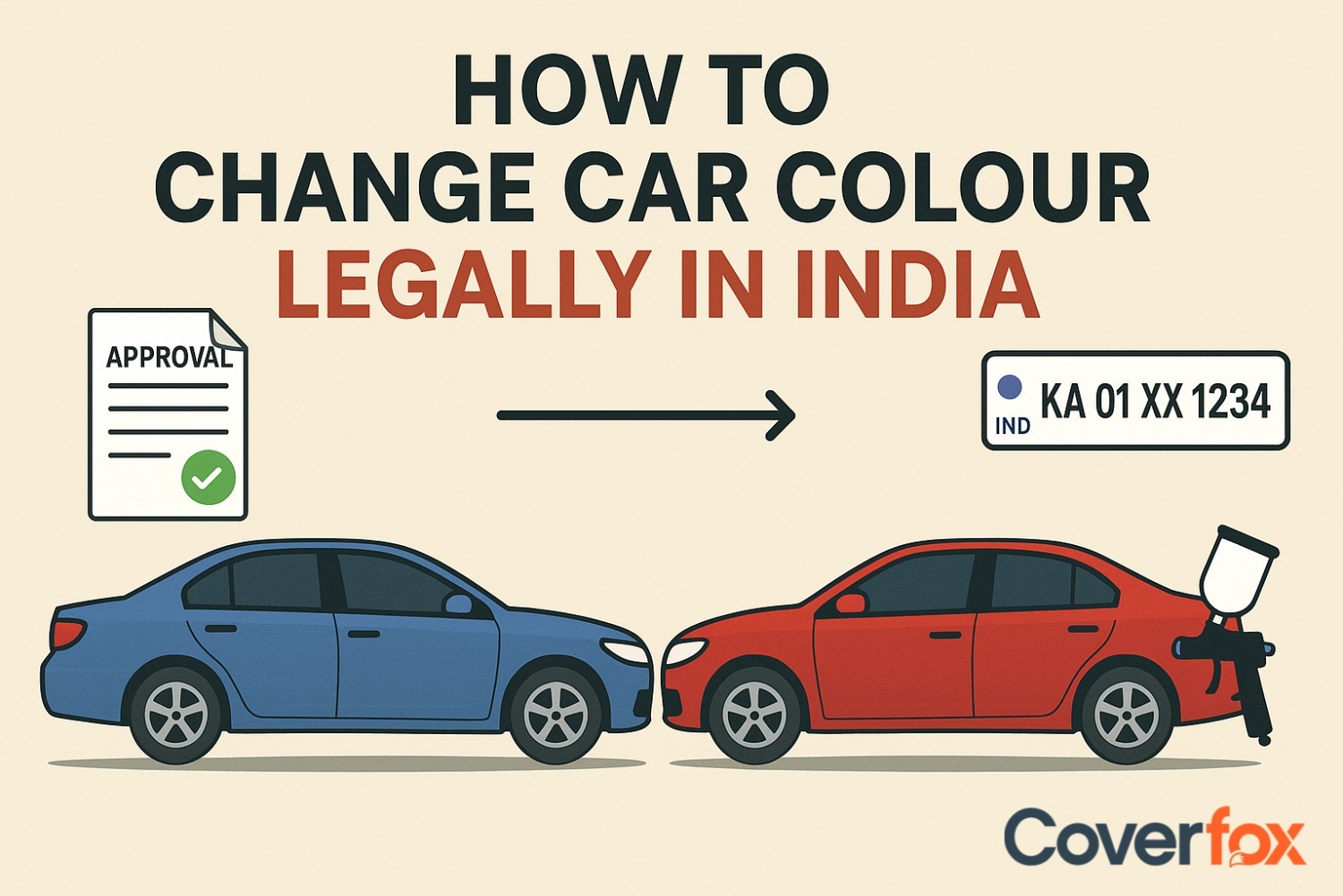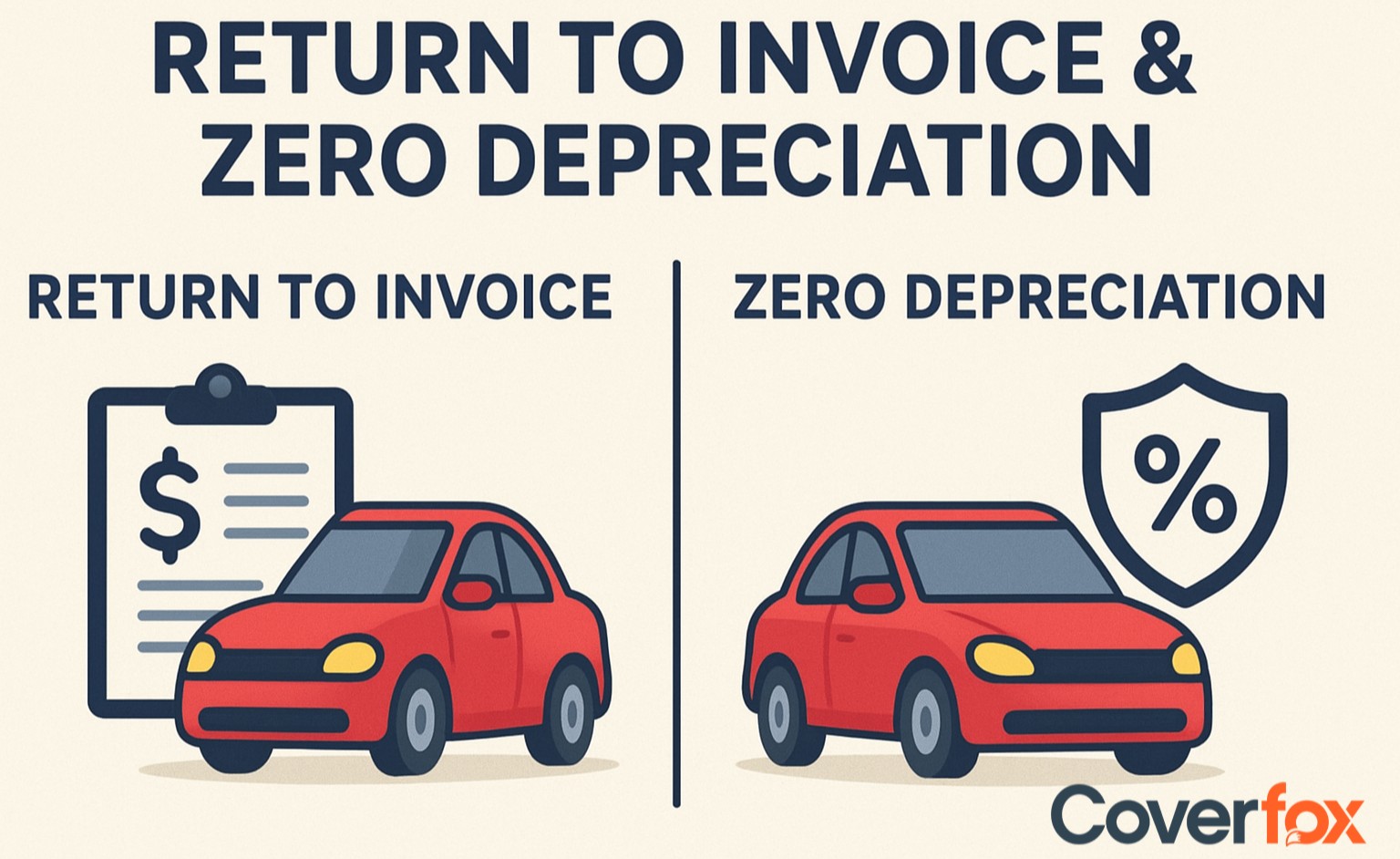Changing a car’s colour in India is fully permitted, but it must follow the legal process to remain compliant with the Motor Vehicles Act. Updating the new colour in the Registration Certificate and informing the insurer ensures that the vehicle’s identity is accurate, prevents penalties, and keeps insurance coverage valid. Following proper procedures safeguards against legal complications, claim issues, and resale problems.

Changing your car’s appearance can feel exciting, especially when you decide to change car colour to give it a fresh and personalised look. In India, changing your car’s colour is completely allowed, but you must follow proper legal procedures to avoid penalties or complications later.
Why You Need to Change Car Colour Legally
Legally updating your vehicle’s documents after a colour change for the car is essential because the colour mentioned in your Registration Certificate forms part of the vehicle’s identity. If you repaint your vehicle without officially recording the new shade, it is treated as an unauthorised modification and may attract penalties under Section 52 of the Motor Vehicles Act. Failing to update the RC can also cause issues with insurance validity, since your insurer relies on accurate details to assess claims, particularly in theft or accident cases where proper identification is crucial. Registering the new colour ensures legal compliance, prevents disputes, and keeps your insurance protection fully intact.
Rules and Regulations for Changing Car Colour in India
Changing the exterior look of your vehicle is allowed in India, but the process must follow specific rules to ensure that the new appearance matches the details recorded in your Registration Certificate. Proper approval is essential to avoid legal issues and keep your documents accurate.
RTO Approval Requirement
Minor Shade Flexibility
Restrictions on Reserved Colours
Mandatory RC Update
Before making a noticeable colour change, you must obtain written permission from the RTO, since Section 52 of the Motor Vehicles Act treats any alteration affecting RC details as a regulated modification.
Some RTOs allow minor shade variations (e.g., White → Pearl White or Red → Wine Red) without separate approval, as long as the vehicle visually resembles the registered colour. However, this is not uniform nationwide. Always confirm with your local RTO before repainting.
According to Rule 121(1) of the Central Motor Vehicles Rules, 1989: “No motor vehicle, including agricultural tractor and construction equipment vehicle, shall be painted in olive green colour except those belonging to the Defence Department.”
Examples
✔ Allowed with approval: Blue → Matte Blue, Silver → Metallic Grey
✘ Not allowed: Any camouflage pattern, Olive Green, Military Beige, police-style white-with-blue-stripes
Once the RTO approves the repaint, the new colour must be endorsed in the RC to ensure full compliance and prevent penalties or objections during routine checks.
Step-by-Step Process to Change Car Colour Legally
To legally complete a colour change on a car in India, you must follow the RTO-approved alteration procedure and ensure the new colour is officially recorded in the Registration Certificate. Below are the clear, step-by-step requirements to complete the process without facing legal issues or insurance complications.
Decide the New Colour and Check Restrictions
Fill the NAMV Form for Alteration Approval
Prepare the Required Documents
Submit Documents at the RTO
Pay the Applicable RTO Charges
Repaint or Wrap the Vehicle After Approval
Present the Vehicle for Inspection
Get the Updated Colour Endorsed on the RC
Inform Your Insurance Provider
Select a permissible colour and avoid army green, camouflage designs or police-style patterns, since these are restricted for private vehicles.
Fill the NAMV Form (Notice of Alteration of Motor Vehicle) — sometimes labeled Form 22 or Form 33 in certain states. Confirm with your RTO which version they accept.
Keep your RC, insurance certificate, PUC, identity proof and the filled NAMV form ready. If the vehicle has a loan, some RTOs may ask for a financier NOC.
Visit your registering RTO, submit the NAMV form and attach a colour sample or shade reference for verification before repainting. Typical approval timeframe: 2–14 days depending on RTO workload.
Pay the official alteration and endorsement fees as instructed by the RTO. Repainting expenses are separate and depend on the workshop you choose. RTO alteration endorsement fees usually range from ₹300–₹800, depending on the state. Painting costs (₹8,000–₹40,000) or wrapping costs (₹15,000–₹60,000) are separate and depend on material quality.
Once you get the go-ahead from the RTO, proceed to repaint or wrap the car using a reliable and professional workshop to ensure a proper finish and durability.
Return to the RTO with your repainted vehicle for physical verification. The inspector will check whether the new colour matches the approved shade.
After a successful inspection, the RTO will update and issue the RC with the new colour mentioned, completing the legal process.
Notify your insurer about the updated colour so that your policy records remain accurate and your coverage continues without any complications during claims.
Documents Required for Changing Car Colour
To apply for a legal Car Colour Modification in India, you must submit a specific set of documents to the RTO so that the new colour can be approved and officially updated in your Registration Certificate. These documents help verify ownership, vehicle identity and compliance with the Motor Vehicles Act.
Documents Required
- Original Registration Certificate (RC) with photocopies
- Valid motor insurance certificate
- Valid Pollution Under Control (PUC) certificate
- Owner’s identity proof, such as Aadhaar, PAN, voter ID or passport
- Owner’s address proof matching RTO records
- Filled NAMV form (Notice for Alteration of Motor Vehicle) specifying the new colour
- Passport-sized photographs of the owner if required by the RTO
- Financier’s NOC if the car is under loan or hypothecation
- A clear colour sample, swatch, or shade reference of the proposed new colour
Submitting these documents ensures a smooth verification process and allows the RTO to legally update the colour change in your RC.
Why Notify Your Insurer About a Colour Change?
Notifying your insurer after a car repaint is essential because the colour mentioned in your policy must match the vehicle’s actual appearance for the insurer to consider the details accurate and valid. When you make a change and do not update your insurer, it creates a mismatch in policy records, which can lead to complications during claim verification, particularly in theft or accident cases where vehicle identification is crucial. Even though the repaint itself does not directly affect the car change colour, failing to disclose the modification can result in delays, reduced payouts or even rejection of claims because the insurer may classify the change as an undeclared alteration. Updating the colour keeps your policy transparent, prevents disputes, and ensures uninterrupted coverage.
Penalties for Changing Car Colour Without Approval
Changing your vehicle’s appearance without following the legal process can create several serious complications for car owners in India. Since the colour listed in the Registration Certificate must match the vehicle’s actual look, repainting without approval is treated as an unauthorised alteration and can trigger multiple penalties.
Fines for Unapproved Alteration
Risk of Vehicle Detention
Insurance Claim Rejection
Lower Resale Value
Authorities can impose penalties under the Motor Vehicles Act if you repaint the vehicle without prior RTO permission, even if the car's change of colour seems minor to you.
During routine checks, the police may detain the vehicle for verification if the colour does not match the RC, causing inconvenience and delays.
Insurers may question or reject claims because the policy information no longer matches the vehicle’s actual appearance, especially in accidents or theft cases.
Buyers and dealers usually avoid vehicles with documentation mismatches, which can reduce the resale value and make selling the car more difficult.
Car Wrapping vs. Repainting: Rules and Insurance
When deciding between car wrapping and repainting, it is important to understand how each option is treated under Indian laws and insurance norms. Both methods alter the vehicle’s appearance, but the approval process, long-term durability and overall practicality differ significantly.
| Aspect | Repainting | Full Body Wrap |
|---|---|---|
| Legal Requirements | Full colour change needs RTO approval and RC update | Full colour change needs approval and RC update. Partial wraps usually do not |
| Insurance | Must inform the insurer to avoid claim issues | Full wrap must be declared. Non-disclosure can delay claims |
| Cost | More costly, especially premium finishes | Mid-range cost depending on wrap quality |
| Durability | Long-lasting with good maintenance | May fade or peel, but protects the original paint |
| Reversibility | Permanent change | Can be removed easily and reversed anytime |
Common Mistakes When Changing Car Colour
Car owners often make avoidable errors when planning a colour change for their car, mainly because they overlook legal requirements or try shortcuts that lead to complications later. Understanding these mistakes helps ensure a smooth, compliant and long-lasting colour update.
1. Skipping RTO Notification
Many owners repaint the vehicle without informing the RTO, which results in a mismatch with the RC and can attract penalties during police checks.
2. Choosing Prohibited Shades
Selecting colours that resemble army, camouflage or police vehicles is a common mistake. These shades are legally restricted and can lead to fines or forced removal.
3. Not Updating the Insurer
Failing to notify your insurance provider after repainting can cause claim disputes, since insurers rely on accurate vehicle details for verification.
4. Opting for Low Quality DIY Work
Using cheap paint, poor quality wraps, or unprofessional DIY methods can lead to peeling, fading and uneven finishes, reducing the car’s durability and resale value.
5. Ignoring Documentation Requirements
Some owners forget essential documents like the NAMV form, RC, PUC or colour samples, which delays approval and verification at the RTO.
Common RTO Approval Problems (and Fixes)
Colour description mismatch:
- RTO rejects “Midnight Teal” if not a standard automotive colour name.
- Fix: Use standard shades (e.g., Teal Blue).
Improper shade samples:
- Too small or inconsistent samples lead to re-inspection.
Inconsistent vehicle photos:
- Submit clear front, rear, side photos for records.
Skipping hypothecation NOC:
- Mandatory if the vehicle is under finance.
How a Car Colour Change Affects Your Insurance
A repaint or wrap can seem like a simple upgrade, but it directly affects how your insurer identifies and re and fully valid.
Impact on Policy Records
Risk During Claim Verification
Possibility of Claim Rejection
Maintaining Full Coverage
Your insurance policy lists essential identification details, including the colour of the vehicle. If this information no longer matches the car’s current appearance, the policy is considered incomplete or inaccurate.
During theft or accident claims, insurers compare the policy details with the actual vehicle. A colour mismatch can raise suspicion, delay verification or prompt the insurer to request additional proof.
Non-disclosure of a major modification is treated as a breach of policy terms. If the colour update was not informed, the insurer may reject the claim based on incorrect or undisclosed information.
Updating the colour ensures that your comprehensive cover remains valid, prevents disputes and keeps your policy transparent, protecting you from complications during settlement.
Summing Up
Changing your car’s colour in India must always be done through the proper legal route. Obtaining RTO approval and updating the colour in the Registration Certificate ensures the vehicle remains compliant with the Motor Vehicles Act and avoids penalties for unauthorised alterations. Informing your insurer is just as important, since accurate details help maintain valid coverage and prevent claim disputes. By following these simple requirements, car owners protect themselves from legal issues, ensure smooth identification of their vehicle and keep their car insurance fully effective.
Articles to Read:
Car Modifications in India: Legal and Illegal Customisations
Guide to Choosing the Right Car Coating
How will Modifications Affect My Car Insurance?
Frequently Asked Questions
Is it legal to change my car's colour in India?
Yes, it is legal to change car colour in India, but you must take RTO approval and update the new colour in your Registration Certificate to stay compliant.
How does changing my car's colour affect my insurance policy?
A colour change for a car affects insurance because the policy details must match the vehicle’s actual appearance for smooth claim verification.
Do I need to inform my insurer after changing my car’s colour?
Yes, you must inform your insurer after changing your car’s colour, otherwise incorrect details may lead to delays or complications during claims.
What are the penalties for not updating my RC after a colour change?
If you change the colour of a car without updating your RC, you may face fines, issues during police checks and even claim-related problems.
How long does it take to get RTO approval for a colour change?
Anywhere from 2 days to 2 weeks depending on state RTO workload, inspection queue, and document completeness.
Which car colours are prohibited in India?
Army green, camouflage patterns and police-style colours are not allowed for private vehicles, since these shades are reserved for official use.
Is car wrapping considered legal in India?
Yes, car wrapping is legal, but a full wrap that changes the original shade is treated as a colour change on a car and requires RTO approval and RC update.
Can I change my car’s colour without informing my insurer?
No, not informing your insurer can create mismatched policy details, which may lead to complications or rejection during claim settlement.
Do I need to update my FASTag after changing colour?
No. FASTag is linked to the vehicle number, not the colour.





